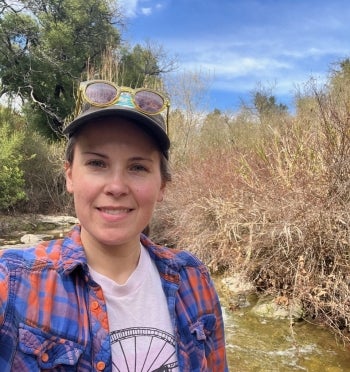New interdisciplinary research highlights wildfire impacts on water and ecosystems in arid regions

Sonoran Desert vegetation burned in the Arizona Bush Fire, June 2020. Photo courtesy of Nancy Grimm
As wildfires increasingly threaten arid regions, a new conceptual framework developed by a team of researchers offers a fresh perspective on the relationship between fire, water quality and ecosystem recovery.
Led by Tamara Harms, ASU School of Life Sciences alumna and associate professor at the University of California, Riverside, a collaborative study titled "Fire influence on land–water interactions in aridland catchments" was recently published in BioScience and emphasizes the importance of interdisciplinary collaboration and watershed-focused research.
“This paper is conceptual, so we were a collaborative group of people with expertise in an array of disciplines across ecology, biogeochemistry, hydrology, terrestrial and aquatic perspectives,” Harms said.
The research team included scientists from Arizona State University, the University of California, the University of Nevada, Duke University, Montana State University and the University of New Mexico. Their joint effort identified critical gaps in understanding and proposed a roadmap for future research to mitigate the impacts of wildfires on arid-land ecosystems.
Collaboration across disciplines
The study underscores the value of synthesis research, which brings together experts from diverse fields to tackle complex environmental challenges. By combining knowledge from ecology, hydrology and biogeochemistry, the team created a comprehensive framework to study the interconnected impacts of fire on land and water.
The synthesis process began during the COVID-19 pandemic, with researchers meeting regularly via video calls. Later, a five-day in-person workshop supported by the National Science Foundation’s Long-Term Ecological Research program at the National Center for Ecological Analysis and Synthesis in Santa Barbara, California, accelerated progress. This intensive brainstorming session enabled the team to consolidate ideas and refine their conceptual framework.
“This group’s ability to collaborate across disciplines was key to our success,” Harms said.
The research also incorporated long-term ecological data, including insights from Sycamore Creek in Arizona, studied extensively by co-author Nancy Grimm, School of Life Sciences Regents Professor, Virginia M. Ullman Professor of Ecology and special advisor to the director for charter initiatives.
The long-term data provided valuable context for understanding how fire affects hydrology and biogeochemical processes. Grimm pointed out wildfire in the desert was historically rare but is becoming more frequent with the spread of introduced grasses that provide fuel, especially during wet years. “In over 40 years studying Sycamore Creek, I have only seen large wildfires in the last five years — the Bush Fire in 2020 and the Sand Stone Fire in 2024,” she said.
Collaboration between people of different backgrounds is important in addressing big problems in science and beyond because their diverse personal and professional experiences — shaped by factors such as location — allow for a broader and more informed approach to tackling complex environmental challenges.
Watershed connections
The research focuses on watershed dynamics — how changes in one part of the landscape, such as vegetation loss or soil erosion, can impact downstream ecosystems. The team highlighted how precipitation patterns heavily influence the timing and scale of fire effects on water quality.
“Our perspective is unique because we focus on watershed connections,” Harms said. “This means looking at how disturbances in upland areas affect aquatic ecosystems downstream.”
In arid regions, fire effects are often delayed until heavy rains transport ash and sediment into waterways. These events can lead to sudden spikes in water contamination or prolonged impacts, depending on the frequency and intensity of rainfall.
The study also explored feedback mechanisms, such as how frequent fires may encourage the growth of fire-tolerant vegetation or how erosion caused by fire can further destabilize soil. Possible recovery efforts after wildfires include monitoring the watershed and assessing the content of debris and fire impact to better understand and mitigate long-term effects on ecosystems.
The team outlined several priorities for addressing knowledge gaps, including the establishment of long-term monitoring networks to gather data on hydrology and water quality over time, investigating feedback mechanisms to understand how fire interacts with hydrologic and ecological processes in ways that stabilize or destabilize ecosystems, developing predictive modeling tools to forecast how arid-land ecosystems will respond to fire and precipitation changes, and continuing interdisciplinary collaboration by bringing together experts from various fields to address complex questions.
The findings have potential applications for policymakers and land managers. By emphasizing the interconnectedness of upland and aquatic systems, the research provides guidance for protecting water resources, restoring ecosystems and mitigating fire impacts.
More Environment and sustainability

From environmental storytelling to hydroponics, student cohort crafts solutions for a better future
A select group of students from Arizona State University's College of Global Futures, a unit within the Julie Ann Wrigley Global Futures Laboratory, is laying the foundation to drive change…

2 ASU faculty elected as AAAS Fellows
Two outstanding Arizona State University faculty spanning the physical sciences, psychological sciences and science policy have been named Fellows of the American Association for the Advancement of…

Homes for songbirds: Protecting Lucy’s warblers in the urban desert
Each spring, tiny Lucy’s warblers, with their soft gray plumage and rusty crown, return to the Arizona desert, flitting through the mesquite branches in search of safe places to nest.But as urban…



